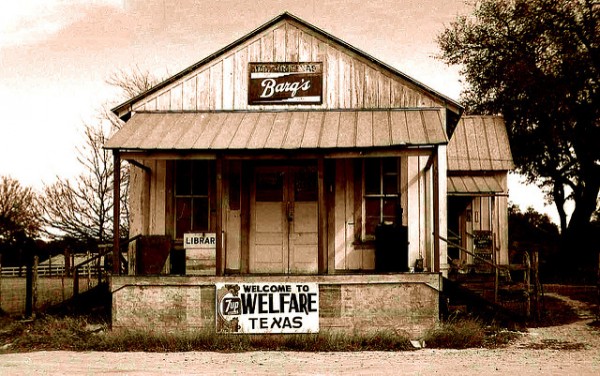
Part 2 of the Council on Contemporary Families’ Symposium on Welfare Reform at 20
Twenty years ago this month, Congress passed the Personal Responsibility and Work Opportunity Reconciliation Act (PRWORA), which repealed the cash assistance program, Aid to Families with Dependent Children (AFDC), and replaced it with a program called Temporary Assistance to Needy Families (TANF).
Myths about welfare at the time
Hostility toward AFDC had been building since the early 1980s, as Philip Cohen explains. While some of the criticisms were legitimate, much opposition was spurred by myths about the history of poverty programs. As President Reagan memorably summed up those myths, “We fought a war on poverty, and poverty won.”
The reality is that the War on Poverty was remarkably successful, even though successive administrations fought it with one arm tied behind the back and retreated in the face of economic challenges that should have elicited heightened efforts, such as the oil crisis of 1973, the stock market crash of 1974, and the 1979 energy crisis.Between the mid-1960s and 1980, poverty rates were almost halved. Poverty rose again in the 1980s in response to deteriorating economic conditions and Reagan-era cutbacks, but economists calculate that in the early 1990s poverty would have been nearly twice as widespread if government programs had not been available.
Racism as well as historical misrepresentation fueled the attack on AFDC. Most Southern states and many Northern ones had successfully excluded Blacks from New Deal jobs and postwar economic assistance programs. As the Civil Rights movement gained clout, this became harder to do and African-Americans, who had long been more likely than whites to experience poverty, now became highly visible on the welfare rolls.
As marriage rates fell and out-of-wedlock births rose, opponents of welfare promulgated a new myth. Unmarried poor women, they argued, were literally reproducing poverty, having babies in order to collect welfare checks. This despite the fact that a year before the repeal of AFDC, a rigorous state by state examination found “no” evidence that welfare was behind the increase in female-headed households. Other studies also refuted the claim that welfare caused the rise in unwed births.
In fact, other countries and American states with the most generous income assistance programs have lower rates of out-of-wedlock births than the US states with the most miserly ones. Recent research shows that unwed births are largely driven by the dynamics of joblessness and inequality, along with the chaotic life situations produced by intense economic insecurity.
Some truths about AFDC

Aside from these falsehoods, however, many observers began to question the AFDC in light of the transformation in the marriage arrangements of the non-poor, as described by Philip Cohen. Originally, cash assistance to families with children was designed to help “deserving” single mothers – mostly widowed or abandoned women – stay home with their children. But as more mothers entered the workforce in the 1980s and early 1990s, it became difficult to justify paying poor mothers to stay home when so many married moms could not afford to do so.
Another problem was that AFDC tended to penalize work and encourage under-the table ways of earning money because the grant was reduced if a recipient earned or reported any extra income. The work deterrent was much more modest than often assumed, but it was real.
One solution would have been to provide a minimum income floor that would not be cut if recipients started taking steps toward full independence. Instead, the 1996 law abolished AFDC’s guarantee of cash assistance to all eligible poor families, giving states a fixed pool of money for income support and work programs, and considerable leeway about how – or whether — to spend that money. The act also imposed strict lifelong limits on the amount of aid a family or individual could receive, no matter how long a person worked in between spells of hardship.
The rise of TANF
Opponents predicted the cuts would lead to “children sleeping on grates, picked up in the morning frozen.” But the first four years of the program seemed to contradict their forebodings. Welfare caseloads fell sharply, and in the context of the expanding job market that America experienced from 1996 to 2000, the majority of adults leaving public assistance found jobs. Few of those jobs paid enough to move a family out of poverty, but the number of families with children in poverty did fall, largely thanks to the Earned Income Tax Credit (EITC), a program that puts extra income back in the hands of low-wage workers.
To the surprise of many conservative as well as liberal skeptics of mandatory work requirements, sending single mothers of young children to work didn’t have the ill effects that many had predicted. Researchers found that mothers’ transition to employment had several positive effects on young children’s cognitive achievement and behavior. And a 2016 study of employed and unemployed single mothers confirms earlier research showing that employed single mothers reported less sadness and stress, and no more fatigue, than non-employed single mothers.

Ominously, however, there were some negative effects of maternal employment on teenagers’ school achievement and behavior, probably due to reduced parental supervision in disadvantaged neighborhoods. Furthermore, the positive impact of maternal employment on children was found only in conjunction with jobs that provided more income than the women had formerly received. Maternal employment coupled with increased income had more positive effects than increased income from welfare alone. But maternal employment that did not increase income over previous assistance levels did not produce positive results.
Under the George W. Bush administration, promoting marriage as a solution to poverty became a more important component of welfare policy. But increases in economic insecurity since then have actually been associated with further decreases in marriage rates, and rigorous evaluations of “healthy family” programs have shown no effect on marriage rates and mixed effects on couples relationships, as Jennifer Randles describes.
TANF’s gaps showing
When the job market weakened after 2000, the holes in the TANF program became more obvious. For individuals unable to find or hold full-time jobs, as well as for people who become unemployed again after using up their lifetime TANF limits, the EITC is no use because one has to earn income to collect benefits. The end of cash assistance has created serious hardship for families where lack of child care, poor education, mental or physical issues, or simply a depressed job market prevents a parent from working.Furthermore, Congress has not changed the funding of the basic grant since 1996, causing its real value to fall by one-third. By 2013, moreover, spending on child-care assistance had been falling for 11 years, and fewer than 20 percent of families eligible for child care subsidies were actually receiving them.
Worse yet, many states used the latitude granted them under the act as a license to divert money from actual assistance to the poor toward other priorities. Louisiana used some of the money to fund anti-abortion pregnancy centers, while Michigan spent part of it on college scholarships. Georgia actually sent letters to welfare applicants saying “we believe welfare is not the best option for your family,” and “TANF is not good enough for any [emphasis added] family.” Those who applied anyway were often rejected for such things as failing to file 24 or more job applications a week.
In June 2015, the Missouri state legislature voted to cut thousands of families off the state’s cash assistance program, reduced the life-time limit for assistance from 60 to 45 months, slashed cash benefits by half for those unable to find jobs, and redirected a significant proportion of welfare funds to pro-marriage and anti-abortion programs.
Real talk: Movement in the wrong direction
Nearly half of all Americans receive some form of government benefits, such as Social Security, food stamps, housing subsidies, the earned-income tax credit, or the child tax credit. Such social welfare programs have reduced poverty by 40 percent since the 1960s and given many low-to-middle-income Americans a higher standard of living than their earnings alone could ensure.But over the past several decades a declining portion of these benefits have gone to the poorest families. In 1995, the AFDC program lifted more than two million children out of deep poverty, accounting for 62 percent of children who would otherwise have been classified as such. By 2010, TANF lifted only 629,000 children — just 24 percent — out of deep poverty.

Two researchers recently calculated that the number of families living for at least part of the year on incomes of just $2 a day per person grew from 636,000 in 1996 to 1.46 million in early 2011, an increase of 130 percent. If we include in-kind benefits, the number of people living on $2.00 a day or less increased to “only” 67 percent in that period, but that’s still a dramatic example of movement in the wrong direction. As Christopher Jencks writes in a carefully balanced evaluation of the research, “the poorest of the poor are… worse off today than they were in 1969.” And a sizable number of those poorest of the poor are children.
Most Americans want people who cannot work to get assistance and people who can work to earn enough to keep them out of poverty. And almost no one wants children to be scarred by the kind of economic deprivation that our current welfare system perpetuates. As Randles argues, there are programs that can help individuals cope better with poverty, both as parents and partners. But 20 years of history demonstrate that few of these have long-term effects on family stability or child outcomes in the absence of improved employment opportunities, wage levels, and social safety nets, including affordable child-care that allows mothers to earn income without leaving their children in dangerous situations.

Comments 1
Joanna Van Brunt — September 7, 2016
This generation is the start of something that is heading in the wrong direction. People have gotten so lazy within these past couple of decades. There are these things called "jobs" that work in an incredible way. See, people actually get up, work for a company, and in return get money. I think people have forget the meaning of getting what you work for.
I work at a bank. Everyday, I see individuals wanting their money that they get paid for by the state for disability. Most of their "disabilities" involved temporary injuries, such as, a hurt hip, sprained ankle, or a sore on their pinky toe. Yet, they still expect that check to be in their bank account when they haven't done anything to deserve it. I know there are people that actually do need and deserve that money, but a majority does not.
Why should my hard earned money be turned into taxes and then sent to lazy people that just expect the world to give them everything? I think that people should at least SOMETHING to get and keep this money, like community service. Give back to the people that help you out. Stop expecting for us to serve you all of the time, and get up and do something. That is why our world is going downhill.